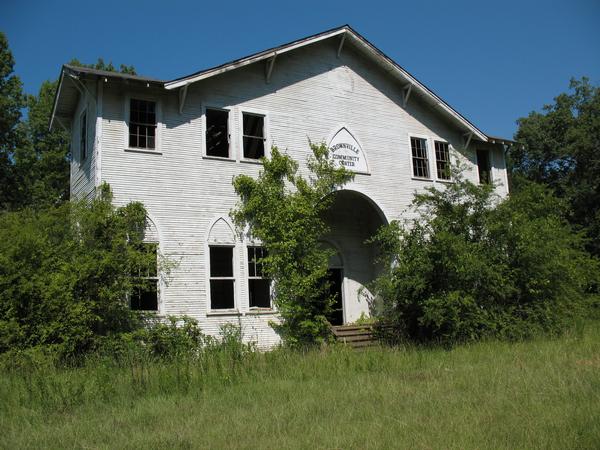
Brownville , AL Abandoned Community Center

History located on the bottom of the page.






I’d like to contribute the first: From Chuck Lett Brownville , AL .
Located a little north west of Northport and accessible from highways 82 and 171, Brownville was once a rather sizeable company town... now, but a ghost of its former self.
And ghost towns seem to be rare east of the Mississippi River . For Brownville, becoming a ghost town happened in a way quite different from the more famous ghost towns of the old west. For Brownville, there was no creeping slum as is usually the case when a town's population dwindles. In Brownville it happened suddenly. Now only three of more than 40 modest wood frame dwellings that provided homes for some 250 people are inhabited. Nature has all but reclaimed Brownville.
Credit this to unusual circumstances. Each family rented its home from the same landlord. Every house was built during a three-year period. For six decades Brownville throbbed with community life, but almost overnight the entire population moved away.
Recently nature got some help from bulldozers, which took down many of the derelict houses. But for the remainder, except for the three houses still occupied, nature is choreographing the demolition and using her own crew.
In western states, when towns are abandoned they become bleached skeletons. Cimmarron , Nevada and Silver City , Idaho , each had a bustling population, but the mines ran out and they were abandoned. Paradise , Arizona , which boasted thirteen saloons, met a similar fate. They dried out and weathered. The buildings yielded all of their paint and something of their posture to the wind. They were blasted by sun and wind-scrubbed by sand. Still, there is a charm to the way nature dealt with them. Equally important is the fact that they remain visible. Such is not the case in the damp, verdant and remote location where the late J. Graham Brown elected to build his lumber treatment plant in 1923.
Also, unlike its western counterparts, there will be no scenic skeletal remains to attract tourists. Brownville is simply disappearing into choking kudzu and skyward-reaching saplings as nature's crew does its work.
Almost as quickly as the people moved out, loblolly pines, sweetgum trees, Japanese honeysuckle, Virginia creeper, Kudzu (of course), and a small army of weeds and grasses promptly moved in. They have claimed all the remaining deserted houses.
These gentle, persistent agents creep through windows and cracks in floors, lean heavily on roofs and gnaw away at wooden underpinning, walls and porches. A 53-inch annual rainfall, average for the area, aids their work.
When the task is finished, nothing will remain of a once-thriving town except for the three occupied houses. There is, of course, the busy lumber treatment plant off to the side, an unconcerned witness, going about its business under new ownership.
However, no motels will spring up inviting tourists to view the town's remains.
While Brownville lived, its community life reflected the fortunes of the Brown Wood Preserving Plant. Its pressure treated poles and lumber are used throughout the country for utility lines, barn construction and fence posts.
Today the plant employs only a fraction of the labor force it once required. All but four of the employees commute. Even so, production is actually up, officials say, due to new methods.
These new methods, however, triggered the death of the town.
In 1923 J. Graham Brown, an entrepreneur from Kentucky , and his brother bought several thousand acres of timberland and built a preserving plant on the site. The remote location meant that housing had to be provided to accommodate employees and their families. More than forty modest frame residences were constructed along dirt roads laid out in the wooded area near the Brown's plant. For the use of these homes, families paid $1 per room each month.
Built in the mid to late 20s, the homes were without indoor plumbing. But they housed a largely contented and productive population.
The Browns, who owned extensive timber interests in several southern states, established a railroad, which they playfully named using the initials of the brother's first names: the M and G line. It served a steam skidder and log train connecting Brownville and Buhl, some twelve miles away.
I DON'T GIVE OUT LOCATIONS. I DON'T KNOW IF THE BUILDINGS ARE FOR SALE. I DON'T KNOW IF THE BUILDINGS ARE STILL STANDING.
Check out our Forums